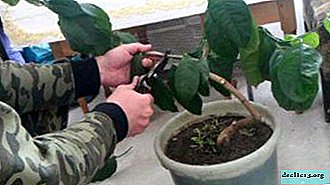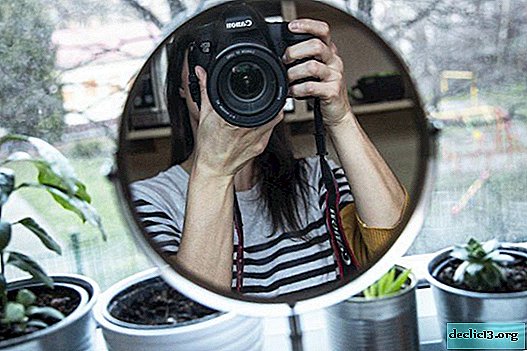What care does a lemon need at home? Features of outdoor cultivation
 Lemon is a tropical, evergreen plant. With large leathery leaves, and prickly branches. At home, the tree blooms for 7-10 weeks. Fruits in 2-3 years after planting. At the same time, lemon is unpretentious in care, which attracts many gardeners.
Lemon is a tropical, evergreen plant. With large leathery leaves, and prickly branches. At home, the tree blooms for 7-10 weeks. Fruits in 2-3 years after planting. At the same time, lemon is unpretentious in care, which attracts many gardeners.
In this article we will tell you how to properly care for the plant at home and on the street in order to get a harvest of juicy fruits from it.
How to care for a lemon tree at home so that it bears fruit?
Temperature
For a good lemon development, it is important to observe a certain temperature regime. During active growth and flowering at least 17 degrees, with fruiting increase from 20 to 28 degrees.
In the autumn-winter period they are kept at an air temperature of 12-14 degrees, away from heating appliances. At the same time, sudden changes in temperature cannot be allowed, this can lead to illness or death of the plant.Lighting
Lemon belongs to the southern plants that love bright diffused light.. Young specimens necessarily shade from direct sunlight. And adult plants tolerate heat well.
The flower needs from 9 to 14 hours of daylight in the spring-summer period and at least 8 hours in the dormant period. Therefore, in the autumn-winter period, additional lighting in the form of fluorescent lamps is installed in a room with a flower. They are placed at least 40-50 cm above the plant level.
Location: on a window or loggia
 For active development, eastern and western window sills are suitable for the plant. On the southern sides with a large amount of light, the flower is greatly extended, and the process of fruit formation slows down.
For active development, eastern and western window sills are suitable for the plant. On the southern sides with a large amount of light, the flower is greatly extended, and the process of fruit formation slows down.- Window sills located on the north side are categorically not suitable for the plant. Due to a lack of light, the leaves grow poorly and the lemon ceases to bear fruit.
- In the summer, the flower can be kept in the loggia or in the fresh air. But it is necessary to ensure that there are no drafts, the lemon does not tolerate them. In the evening, a pot with a plant is wrapped up or brought into the house, so it is protected from sudden changes in temperature.
- Is it possible to rotate the plant on the windowsill? For good growth and beautiful crown formation, the flower is turned several degrees daily to light.
What pot is needed for a houseplant?
- Lemon roots need a large amount of oxygen, so pots that allow good air permeability are suitable for planting, these are clay or wood, in extreme cases plastic.
- You should choose containers with a narrow bottom, and the upper diameter, which is equal to the height. The walls of the pot should be without cavities, even and not thick. Drainage holes are mandatory at the bottom of the pot.
- When transplanting, each new flowerpot should be 2-4 cm larger than the old, if it is a wooden tub - 4-7 cm.
- You can’t buy more pots than necessary, otherwise the plant may become sick and acidify the soil.
How to pinch?
When to pinch a lemon from a stone? Pinch young plants grown from cuttings a year after planting, and from seeds - only after 2 years. Pinched at the end of February.
- A pinch at home is carried out at a height of 9 to 14 cm from the crown of the zero shoot, leaving 5-6 developed leaflets and kidneys. If after the process only one upper bud grows, which continues the same shoot, then it is removed for the growth of other buds. But if 2-3 shoots sprout, they leave the strongest, and the rest cut off.
- After the shoots grow to a length of 15-20 cm, pinch them again, but leave 3-5 leaves.
- To rejuvenate the lemon, the old shoots are cut to the base, leaving only 2-3 kidneys. Of these, new branches soon appear which pinch.
Next, we suggest watching a video on how to pinch a room lemon tree:
Watering
 In the spring-summer period, the plant is watered 3 times a week or as the earthen coma dries. And the leaves are wiped daily with a damp cloth or sprayed from a spray bottle.
In the spring-summer period, the plant is watered 3 times a week or as the earthen coma dries. And the leaves are wiped daily with a damp cloth or sprayed from a spray bottle.- During the dormant period, watering is reduced to 1 time per week, but be sure to spray the trunk circle.
- It is advisable to water the plant in the spring in the morning, in other seasons - in the evening. If the air in the room is dry, install humidifiers or containers with water.
- After watering, for better circulation of water and air, the soil is loosened.
- I use water which is settled or filtered, only at room temperature.
- Distribute the water neatly and evenly until it appears on the pan.
Top dressing
In the summer, the lemon is fertilized once every 2 weeks. How to care for a fruiting indoor tree? In the winter season, if the plant bears fruit, top dressing is carried out once a month. If there are no fruits, then they don’t contribute at all. They feed the flower with organic and mineral fertilizers. Before making the plant must be watered.
Mineral fertilizer can be purchased at the store, the proportion of nutrients N: P: K should be 14:16:18. Dilute the product strictly according to the instructions. For organic fertilizer, manure or chicken droppings are suitable. You can cook it yourself. To do this, the manure is poured with water and left to infuse for a week. Then bred in a ratio of 1:15 and water the plant.
To prevent the development of diseases 2 times a year, it is recommended to cultivate the soil with potassium permanganate.
Priming
For active growth and fruiting of a lemon, light, loose, fertile, breathable soil is required. A mix of citrus plants is available at the store. or soil on a universal basis. And also cook it yourself: for this, two parts of leafy soil are mixed with one part of humus and sand.
For abundant flowering and fruiting, it is advisable to add wood ash or ash to the mixture.
Pruning
The procedure is carried out in March before the plant takes root.. And in winter, as soon as the crop is harvested. The process consists of the following steps:
 The vertical shoot (it is also called the first-order shoot) is cut at a height of 14-20 cm, leaving 4 developed buds, from which 3-4 main branches subsequently grow.
The vertical shoot (it is also called the first-order shoot) is cut at a height of 14-20 cm, leaving 4 developed buds, from which 3-4 main branches subsequently grow.- When new shoots reach a length of 20-30 cm, they pinch off the very tip of the sprout.
- Then, as soon as the shoots of the second order grow, they are cut off by 20-25 cm.
- All further shoots are cut 5-8 cm shorter than the previous ones.
- On shoots of the 4th order, the process of bark formation ends. It is with them that the lemon begins to bear fruit.
- The shoots that have already yielded fruits are shortened by 3/4 of the length.
To harvest each year, some of the flowers are removed. Due to their large number, the lemon is depleted, the number of ovaries decreases, and it is from them that the fruits are obtained. Therefore, the more flowers cut, the larger will be a suitable ovary.
Formation
Pruning is done in early spring, it is done to maintain the lemon crown in an attractive form, as well as to bloom and stimulate plant growth. During the process, fatty shoots are cut off, and long ones that shorten the external beauty are also shortened.
When removed, the branches are completely cut off at the base, and when shortened by 3-6 mm above the kidney selected for further growth. Make a cut with a sharp sterile knife at an angle.During the procedure, you need to monitor the direction of growth of future shoots. The kidney closest to the pinching site should look down if you need to grow a horizontal branch. And for a vertical branch, it is directed to the center of the crown or up.
Tree transplant house
The procedure is transplanted in spring or early autumn before the onset of cold weather. Lemons older than three years are transplanted every 2-3 years. Young specimens do not touch at all.
The transplant process takes place as follows:
- Plant abundantly watered.
- Carefully pull out the lemon without breaking the earthen coma. Inspect, remove dried roots, places of slices sprinkled with crushed coal.
- At the bottom of a new pot, a drainage layer is poured, and on top of the prepared soil.
- The plant, together with an earthen lump, is installed in the center of the flowerpot, covered with remaining soil and watered abundantly.
After transplantation, they are looked after, like an adult plant.
Next, we suggest watching a video on how to transplant a lemon yourself:
Features of growing lemon tree in open ground
 Lemon is a tropical plant, therefore, in our country with severe frosts, it is rarely grown in open ground. Even with short-term frosts up to -4 degrees, there is already a slight freezing of shoots, plant death occurs at -9 degrees.
Lemon is a tropical plant, therefore, in our country with severe frosts, it is rarely grown in open ground. Even with short-term frosts up to -4 degrees, there is already a slight freezing of shoots, plant death occurs at -9 degrees.
Lemon is planted in southern regions where severe frosts are rare. But this process is very laborious:
- With the onset of spring, when the earth is fully warmed up, root-growing seedlings are planted, which are 1-2 years old.
- Digging a trench on the north side is strictly perpendicular, and on the south at an angle of 45 degrees. The depth of the pit should be at least 1.5 m. A drainage layer is laid at the bottom of the trench.
- The northern part is sewn up with boards or covered with white brick. And on the south side there is agrofibre. A polycarbonate greenhouse is installed on top.
- Mounds are made from the nutrient mixture, on top of which the seedling is set. The roots are straightened, and sprinkled on top of the substrate. Then abundantly watered, and sprinkled with mulching material.
The planted tree is necessarily fertilized, while the consumption of fertilizing depends on the age of the seedlings.
Lemon, which is not 5 years old, needs 90-110 g of phosphorus fertilizers, 60-80 g of potash and nitrogen fertilizing. For seedlings older than 6-10 years, portions are doubled, and for plants that are more than 10 years old, triple. And also fertilize with the help of humus and compost.Water the lemon regularly but sparingly. In the first years of life, crown formation is also produced. The branches of the first order are shortened to 40 cm, and the next ones are 5-7 cm shorter. Dry, diseased shoots, and excess inflorescences are also removed.
Preparation for wintering begins in advance. The branches that are located above the edge of the pit are pinned to the bottom or to the wall. The trench itself is covered with a boardwalk. And a layer of soil 35-45 cm thick is poured on top.
In early spring, with the advent of warm days, the flooring is cleaned, the shoots are straightened, and the polycarbonate greenhouse is returned to the place.
Caring for a lemon at home is not so difficult, you need to water it on time, feed it, provide a rest period and good lighting, and then it will delight its fruits. But to grow in the open ground is quite difficult, it will take a lot of time and effort.

 For active development, eastern and western window sills are suitable for the plant. On the southern sides with a large amount of light, the flower is greatly extended, and the process of fruit formation slows down.
For active development, eastern and western window sills are suitable for the plant. On the southern sides with a large amount of light, the flower is greatly extended, and the process of fruit formation slows down. In the spring-summer period, the plant is watered 3 times a week or as the earthen coma dries. And the leaves are wiped daily with a damp cloth or sprayed from a spray bottle.
In the spring-summer period, the plant is watered 3 times a week or as the earthen coma dries. And the leaves are wiped daily with a damp cloth or sprayed from a spray bottle. The vertical shoot (it is also called the first-order shoot) is cut at a height of 14-20 cm, leaving 4 developed buds, from which 3-4 main branches subsequently grow.
The vertical shoot (it is also called the first-order shoot) is cut at a height of 14-20 cm, leaving 4 developed buds, from which 3-4 main branches subsequently grow.















